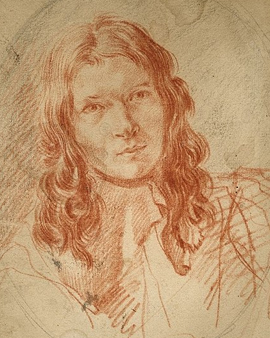The Golden Age of Dutch painting describes a unique phase in the history of art. Trade had brought wealth to the country and developed a prosperous social class. The liberal country opened up to the outside world and became a central point of trade. One of the most sought-after goods was art. Countless artists worked on their works to meet the great demand for paintings. Especially in the cities, collectors allowed cabinets of paintings to grow, bringing together the art of the masters. The Golden Age led to a reflection among collectors, which supported the purchase of Dutch artists and was intended to protect the cultural assets of their own country. Besides Rembrandt, Vermeer and van Goyen, the painter Philips Wouwerman made it into the large cabinets. Born in Harlem, he quickly found access to art and managed to remain the darling of art collectors over a long creative period.
Wouwerman began his career by painting in the style of the Bamboccianti. Following Pieter van Lear, Wouwerman created battle scenes with a distinct Italian influence. Gradually Philips developed his own style and devoted himself to the representation of a wide range of themes. The landscape of his Flemish homeland was a subject that the artist used as well as painting military and religious themes. Wouwerman had a fine painting style and gave his paintings an elegant and unobtrusive coloration. With love for detail Philips captured scenes to which he added esprit and a touch of humor. Philips Wouwerman achieved something unique with the depiction of horses. Regardless of the breed, he created an extraordinarily lively and lifelike image. Capturing the play of muscles and capturing the movement with the swing of mane and tail, Philips succeeded like no other artist.
Philips Wouwerman knew the economic side of art as well as creativity. He satisfied market demand over a long period of time and was still able to make profits when the Golden Age was drawing to a close. The secret lay, on the one hand, in his thematic range. On the other hand Wouwerman very quickly adopted modern stylistic devices and influences to which art was exposed. Wouwerman was careful to observe the market and had the talent to realize the wishes of the buyer perfectly. Perhaps the art market today would speak of an opportunistic character, the economic success spoke for the Dutch painter. His works found their way into the largest European collections of paintings.
×





.jpg)
.jpg)
.jpg)
.jpg)
.jpg)
.jpg)
.jpg)
.jpg)
.jpg)
.jpg)
.jpg)
.jpg)
.jpg)
.jpg)
.jpg)
.jpg)
.jpg)
.jpg)
.jpg)
.jpg)
.jpg)
.jpg)
.jpg)
.jpg)
.jpg)
.jpg)
.jpg)
.jpg)
.jpg)
.jpg)
Prenten_naar_sch_-_(MeisterDrucke-1362474).jpg)
Prenten_naar_sch_-_(MeisterDrucke-1362474).jpg)
_-_(MeisterDrucke-409289).jpg)
_-_(MeisterDrucke-409289).jpg)
.jpg)
.jpg)
.jpg)
.jpg)
.jpg)
.jpg)
.jpg)
.jpg)
.jpg)
.jpg)
.jpg)
.jpg)
.jpg)
.jpg)
.jpg)
.jpg)
Prenten_naar_s_-_(MeisterDrucke-1369042).jpg)
Prenten_naar_s_-_(MeisterDrucke-1369042).jpg)
.jpg)
.jpg)
.jpg)
.jpg)
.jpg)
.jpg)
.jpg)
.jpg)
.jpg)
.jpg)
.jpg)
.jpg)
.jpg)
.jpg)
.jpg)
.jpg)
.jpg)
.jpg)
.jpg)
.jpg)
.jpg)
.jpg)
.jpg)
.jpg)
.jpg)
.jpg)
.jpg)
.jpg)
.jpg)
.jpg)
.jpg)
.jpg)
.jpg)
.jpg)
.jpg)
.jpg)
 - (MeisterDrucke-558272).jpg)
 - (MeisterDrucke-558272).jpg)
.jpg)
.jpg)
.jpg)
.jpg)
.jpg)
.jpg)
.jpg)
.jpg)
_-_(MeisterDrucke-36329).jpg)
_-_(MeisterDrucke-36329).jpg)
.jpg)
.jpg)
.jpg)
.jpg)
.jpg)
.jpg)
.jpg)
.jpg)
.jpg)
.jpg)
.jpg)
.jpg)
.jpg)
.jpg)
.jpg)
.jpg)
.jpg)
.jpg)
.jpg)
.jpg)
.jpg)
.jpg)
.jpg)
.jpg)
Prenten_naar_sc_-_(MeisterDrucke-1368246).jpg)
Prenten_naar_sc_-_(MeisterDrucke-1368246).jpg)
.jpg)
.jpg)
.jpg)
.jpg)
.jpg)
.jpg)
Prenten_na_-_(MeisterDrucke-1368234).jpg)
Prenten_na_-_(MeisterDrucke-1368234).jpg)
.jpg)
.jpg)
.jpg)
.jpg)
.jpg)
.jpg)
.jpg)
.jpg)
.jpg)
.jpg)
.jpg)
.jpg)
.jpg)
.jpg)
.jpg)
.jpg)
.jpg)
.jpg)
.jpg)
.jpg)
.jpg)
.jpg)
.jpg)
.jpg)
_-_(MeisterDrucke-1357073).jpg)
_-_(MeisterDrucke-1357073).jpg)
.jpg)
.jpg)
.jpg)
.jpg)
.jpg)
.jpg)
.jpg)
.jpg)
.jpg)
.jpg)
.jpg)
.jpg)
.jpg)
.jpg)
.jpg)
.jpg)
.jpg)
.jpg)
_-_(MeisterDrucke-1356808).jpg)
_-_(MeisterDrucke-1356808).jpg)
.jpg)
.jpg)
.jpg)
.jpg)
.jpg)
.jpg)
.jpg)
.jpg)
.jpg)
.jpg)
.jpg)
.jpg)
.jpg)
.jpg)
.jpg)
.jpg)
_-_(MeisterDrucke-1371605).jpg)
_-_(MeisterDrucke-1371605).jpg)
.jpg)
.jpg)






